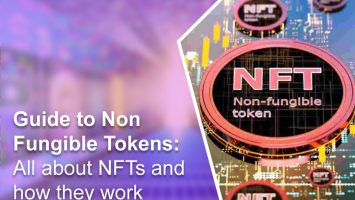
NFTs can represent real-world objects like art and real estate. These physical, real-world products can indeed be “tokenized” to increase their trading ability and reduce the possibility of fraud. In this article, you would be provided with detailed information about how NFTs are stored in the wallet, NFT art wallet address, applications of NFTs, and various methods for storing NFTs.
How to receive NFTs on Trust Wallet?
You will require an asset-supporting wallet in order to receive NFTs. A multi-coin wallet called the trust wallet does not accept NFTs.
You must find a digital wallet with the ability to receive NFTs and support for the block chain on which the NFT is issued in order to receive the NFTs.
Applications of NFTs
- Fashion
- Art
- Sports
- Gaming
- Certifications
Programmable art is the most popular NFT crypto application because it uniquely combines creativity and technology. There are currently several limited edition pieces of artwork in circulation. Unexpectedly, they provide programmability to make modifications in a variety of circumstances.
If you owned a Monet or a Van Gogh that was physically valued at millions of dollars, you would undoubtedly spend a significant amount of cash and time finding the ideal location to preserve it safely.
The same is true of NFTs, or nonfungible tokens. Some of them are worth thousands or millions of dollars; however, they are not yet regarded as being on the same scale as the classical creation of the greatest artists in history. In order to prevent compromising access to personal investments, it may be essential to learn how to store nonfungible assets.
As described earlier, Non-fungible tokens are other than works of art. They can symbolise anything, such as a creative image, a music video or audio, digital proof of a person’s identification, academic degrees, ownership of a car or property, etc.
Digital assets might be copied and disseminated before blockchain. The majority of products were practically worthless without understanding what and where the underlying digital asset was.
Blockchain enables the creation and validation of original works so that creators can manage their assets in a trustless environment without the need for middlemen. Blockchain also offers an immutable digital ledger.
This innovation is a huge step toward the ownership of digital assets and opens the door to a burgeoning industry over the following ten years, not just for digital arts but also for digital real estate, identities, and gaming, to name a few. To deter digital burglars as well as other scams in the virtual world, it is crucial to keep NFTs appropriately as digital ownership grows to include valuable goods.
NFT Value and Storage
The NFT value has increased to £2.5 billion in the spring of 2021 from £13.7 million in the same period the year before, as per a Reuter’s article. After NFTs burst in popularity, sales volumes have recently stayed high, reaching about £5 billion.
A new record for digital art was reached in March when Christie’s sold an NFT by visual artist Beeple for £50 million. The other particularly pricey NFT sale was a “CryptoPunk” at Sotheby’s, which netted £11.8 million. In October, sales on the well-known NFT marketplace OpenSea hit a new high of £1 billion.
Grimes, a musician, ended up selling some of her digital artwork for more than £6 million, and Jack Dorsey, the creator of Twitter, also sold the artwork.
The market potential for this kind of asset is enormous, especially in light of the fame and financial influence that the Metaverse would have on NFTs. its storage is less complicated which adds to its popularity.
Where to store NFTs correctly?
Nonfungible tokens have soared in value in the past few years, drawing investors as well as hackers hoping to acquire digital artwork or credit card details to purchase more.
A few months back, hackers broke into accounts on the NFT market Nifty Gateway and stole items worth thousands of dollars.
The site attributed the breach to consumers’ failure to employ two-factor verification, which made it simple for hackers to identify users’ login information and take their assets.
The security of the company was not jeopardised. However, some really serious questions about the security of leaving NFTs and any other digital items saved on these third-party systems have been raised.
With the development of NFTs, those certain types of cryptocurrency wallets have been made specifically for storing NFT data, whereas cryptocurrency wallets have only up until now worked for digital assets.
What kinds of NFT storage are offered?
Privacy is just as important for NFT storage as it is for cryptocurrency storage. You run the risk of being the target of cyberattacks, exchange fraud, or single points of failure if you leave them on an exchange.
Decentralized blockchain-based storage is far more secure than centralised storage of digital assets and gives owners complete control over their assets. Additionally, it offers a variety of options for increased mental clarity.
It is important to keep in mind that you shouldn’t keep cryptocurrencies or NFTs in your wallet. Instead, a wallet uses a private key to ensure that everyone has access to the assets stored on the blockchain.
In order to prevent unauthorised access, cyberattacks, and other vulnerabilities common to data connected to the internet, it is crucial to preserve and store NFTs in offline methods for cold storage. This assumes storage in a system that is not networked.
Buying a cold storage hardware wallet and moving the digital assets there is the best option to store NFTs offline.
The wallet won’t be accessible to keyloggers and hackers because it will always be offline. Additionally, each hardware wallet includes a password and ID for additional security.
People can obtain a few precautions to protect their privacy and keep thieves and hackers at bay before delving into the various alternatives.
It is crucial to make sure that the NFT storage solutions you select are compatible with various chains and the marketplace where you purchase and sell NFTs.
It is important to confirm that the wallet is consistent with the Ethereum blockchain because the majority of NFTs are Ethereum-based.
Typical methods for storing NFTs
- Software Wallets
- InterPlanetary File System or IPFS
- Cold Storage Hardware Wallet
Software Wallets
Even for novices and non-techies, establishing an online software wallet is rather simple. Software wallets are the most common solution for holding digital assets due to their user-friendly interface.
In the NFT market, there are many possibilities for software wallets, and most of them feature both mobile and web capabilities.
A software wallet like Metamask, which is simple to set up, is regarded as standard security for your NFTs.
Transactions using Metamask are encrypted and secured by a password and a 12–24 word seed phrase. It was designed as a Chrome extension exclusively. Ethereum and Defi are supported.
Online services like Metamask make them susceptible to hacker attacks. They have been hacked in the past and could still become vulnerable.
InterPlanetary File System or IPFS
A peer-to-peer hypermedia protocol called IPFS enables users to store their decentralised NFTs off-chain, which reduces the risk of hacking.
By adopting content-based addressing in place of the conventional location-based addressing, IPFS modifies how information is disseminated globally.
Your file is divided into smaller bits, cryptographically encrypted, and given a special fingerprint known as a content identifier when you add it to IPFS (CID).
Rather than an HTTP link that can be altered and compromised, content IDs are hashes that are directly associated with a user’s NFT material, providing significant protection.
This CID serves as a record forever of the file, and if you upload a new version to IPFS, the cryptographic hash is changed, thus it can no longer serve as a permanent record.
Cold Storage Hardware Wallet
NFT holders should think about acquiring a hardware wallet which supports cold storage if they want to significantly boost the protection of their funds.
This implies that instead of being stored on the web, where they are vulnerable, the private keys that enable people to access the virtual assets are kept in an extremely secure hardware wallet device.
Due to the fact that 2-factor authentication is always enabled; the hardware wallet offers additional protection. It is not feasible to hack or take the content from the wallet device without actually holding it. Trezor and Ledger are the two most widely used hardware trust wallets. The artwork and any other cryptocurrency are not physically present in the wallets.
Possessing collectables or another digital item shouldn’t ultimately cause problems or concerns about security. There are options today for each and every need, from pricy solutions to inexpensive internet platforms that ensure a largely secure environment. For investors who possess a sizable number of NFTs, options like hardware wallets will be more expensive, however, the improved security they offer might be worth taking into account.
Best NFT to Buy for Beginners 2022
Many NFTs outside have been auctioned for several thousand dollars. Many individuals could believe that they were late to the NFT trend. Some fresh NFTs are, nevertheless, finding their pinnacle in the market such as
- Lucky Block
- Silks Genesis Avatar Collection
- Yubo
- Lazy Goats
- Punk Dogs
- Archaic Art
- Space Apes
- Great Ape Society
- Flyfish Club
- World Of Walrus
Overall, flipping NFTs is the most typical way to benefit from your purchase.
Flipping an NFT often refers to purchasing an NFT and immediately reselling it for a benefit after the market value increases.
Conclusion
On the blockchain, NFTs are stored. After an NFT is acquired and stored in a digital wallet, the smart contract address referring to the NFT’s location on the blockchain is obtained. The NFT’s smart contract’s data is kept online through a file-sharing platform.



Comments (No)